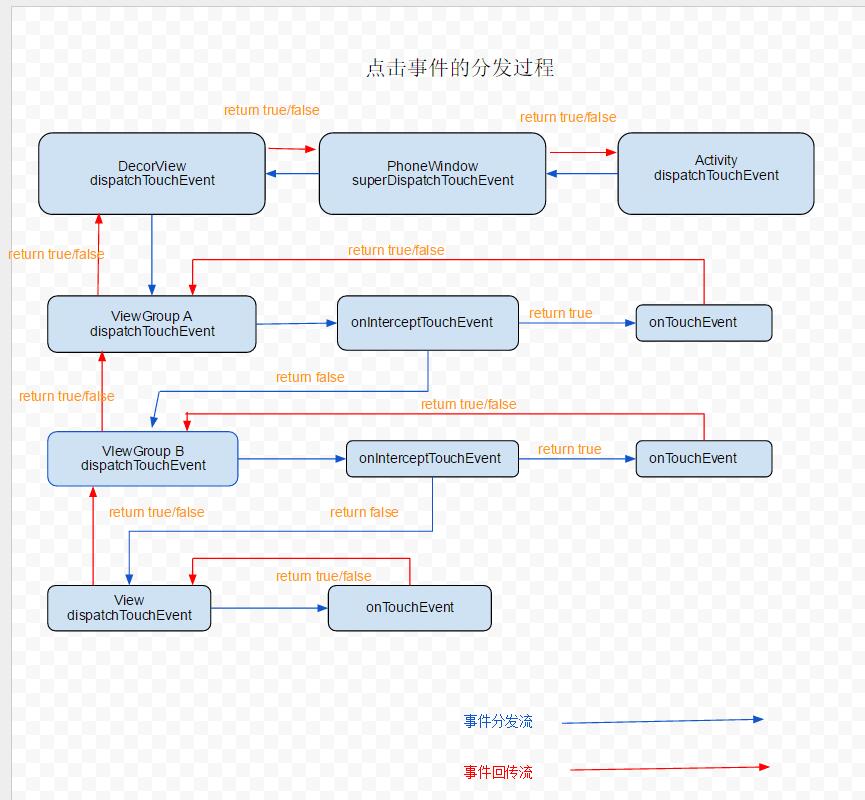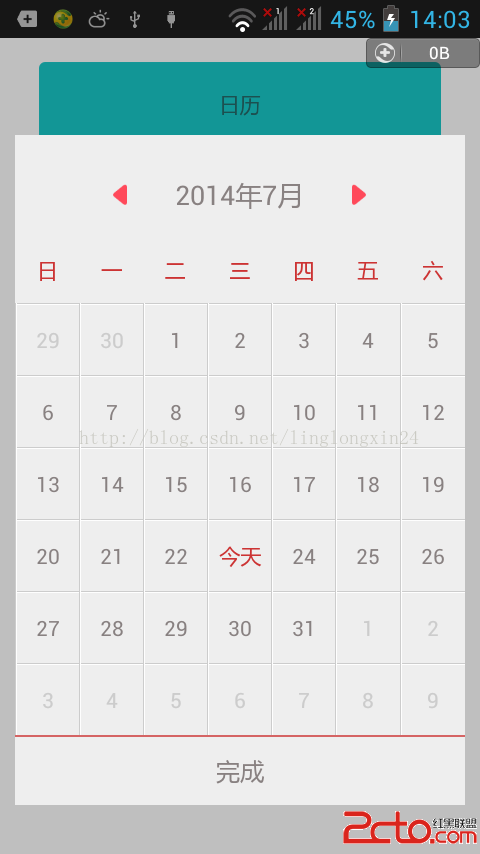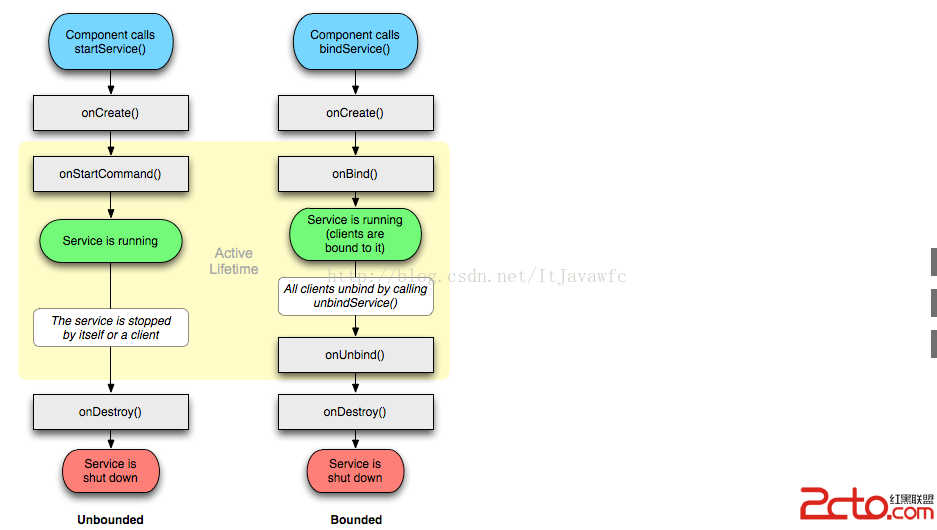編輯:關於Android編程
本文將講述android點擊事件的分發過程
我的上一篇文章講述了android點擊事件的來源,本文接著講述當點擊事件傳輸到Activity之後 分發的過程是什麼樣的。通過上一篇文章我們知道,事件最終會通過activity分發到PhoneWindow再到DecorView最後到他的子View。
那我們就從Activity的dispatchTouchEvent方法看起吧。
Activity#dispatchTouchEvent
public boolean dispatchTouchEvent(MotionEvent ev) {
if (ev.getAction() == MotionEvent.ACTION_DOWN) {
onUserInteraction();
}
//調用 phoneWindow的 superDiapatchTouchEvent
if (getWindow().superDispatchTouchEvent(ev)) {
return true;
}
// 如果phoneWindow#superDiapatchTouchEvent為false ,
// 則會調用Activity的 onTouchEvent
return onTouchEvent(ev);
}
從這段代碼可以看出:activity把事件交給了 phoneWindow,向下傳遞。
如果下層沒有處理這個事件,那麼activity將調用自己的onTouchEvent來處理這個事件。
我們接看PhoneWindow的superDispatchTouchEvent
PhoneWindow#superDispatchTouchEvent
@Override
public boolean superDispatchTouchEvent(MotionEvent event) {
//傳遞給DecorView
return mDecor.superDispatchTouchEvent(event);
}
它將事件傳遞給了DecorView。
DecorView的superDispatchTouchEvent
public boolean superDispatchTouchEvent(MotionEvent event) {
return super.dispatchTouchEvent(event);
}
它這裡調用了super.dispatchTouchEvent(event),實際就是調用了ViewGoup的
dispatchTouchEvent方法。
ViewGroup#dispatchTouchEvent
@Override
public boolean dispatchTouchEvent(MotionEvent ev) {
...
if (actionMasked == MotionEvent.ACTION_DOWN) {
cancelAndClearTouchTargets(ev);
// 1、清除 了disallowIntercept 標記
resetTouchState();
}
// Check for interception.
final boolean intercepted;
// 2 、判斷是否攔截,這個if語句actionMasked == MotionEvent.ACTION_DOWN|| mFirstTouchTarget != null
// 在ACTION_DOWN 或者 mFirstTouchTarget!=null的時候進入
// 通過下文分析會得出:如果不攔截事件,將事件交由子View處理的
//mFirstTouchTarget 不會被賦值,也就是mFirstTouchTarget!=null 不成立。
//那麼就會有一條結論:當ViewGroup攔截事件後,那麼在這個事件序列中,
//將不會進入onInterceptTouchEvent(ev)判斷,而是直接交由ViewGroup自身處理。
//原因是如果攔截了,下個事件不可能是ACTION_DOWN,並且mFirstTouchTarget==null ,所以上述結論成立!
if (actionMasked == MotionEvent.ACTION_DOWN
|| mFirstTouchTarget != null) {
final boolean disallowIntercept = (mGroupFlags & FLAG_DISALLOW_INTERCEPT) != 0;
//3、這個標示可以通過requestDisallowInterceptTouchEvent
//進行設置,這個標志將影響事件的攔截,即如果這個設了這個標志,
//ViewGroup將不攔截事件,但這個對ACTION_DOWN無效,
//原因在於ACTION_DOWN時 會清楚標志,看1號注釋
if (!disallowIntercept) {
intercepted = onInterceptTouchEvent(ev);
ev.setAction(action); // restore action in case it was changed
} else {
intercepted = false;
}
} else {
intercepted = true;
}
// If intercepted, start normal event dispatch. Also if there is already
// a view that is handling the gesture, do normal event dispatch.
if (intercepted || mFirstTouchTarget != null) {
ev.setTargetAccessibilityFocus(false);
}
// Check for cancelation.
final boolean canceled = resetCancelNextUpFlag(this)
|| actionMasked == MotionEvent.ACTION_CANCEL;
// Update list of touch targets for pointer down, if needed.
final boolean split = (mGroupFlags & FLAG_SPLIT_MOTION_EVENTS) != 0;
TouchTarget newTouchTarget = null;
boolean alreadyDispatchedToNewTouchTarget = false;
// 4、如果不攔截將事件往下傳遞
if (!canceled && !intercepted) {
View childWithAccessibilityFocus = ev.isTargetAccessibilityFocus()
? findChildWithAccessibilityFocus() : null;
if (actionMasked == MotionEvent.ACTION_DOWN
|| (split && actionMasked == MotionEvent.ACTION_POINTER_DOWN)
|| actionMasked == MotionEvent.ACTION_HOVER_MOVE) {
final int actionIndex = ev.getActionIndex(); // always 0 for down
final int idBitsToAssign = split ? 1 << ev.getPointerId(actionIndex)
: TouchTarget.ALL_POINTER_IDS;
// Clean up earlier touch targets for this pointer id in case they
// have become out of sync.
removePointersFromTouchTargets(idBitsToAssign);
final int childrenCount = mChildrenCount;
if (newTouchTarget == null && childrenCount != 0) {
final float x = ev.getX(actionIndex);
final float y = ev.getY(actionIndex);
// Find a child that can receive the event.
// Scan children from front to back.
final ArrayList preorderedList = buildOrderedChildList();
final boolean customOrder = preorderedList == null
&& isChildrenDrawingOrderEnabled();
final View[] children = mChildren;
// 5、遍歷子View
for (int i = childrenCount - 1; i >= 0; i--) {
final int childIndex = customOrder
? getChildDrawingOrder(childrenCount, i) : i;
final View child = (preorderedList == null)
? children[childIndex] : preorderedList.get(childIndex);
if (childWithAccessibilityFocus != null) {
if (childWithAccessibilityFocus != child) {
continue;
}
childWithAccessibilityFocus = null;
i = childrenCount - 1;
}
if (!canViewReceivePointerEvents(child)
|| !isTransformedTouchPointInView(x, y, child, null)) {
ev.setTargetAccessibilityFocus(false);
continue;
}
newTouchTarget = getTouchTarget(child);
if (newTouchTarget != null) {
// Child is already receiving touch within its bounds.
// Give it the new pointer in addition to the ones it is handling.
newTouchTarget.pointerIdBits |= idBitsToAssign;
break;
}
resetCancelNextUpFlag(child);
// 6、這個方法將事件分發給子View (即調用子View的 disatchTouchEvent犯法)
if (dispatchTransformedTouchEvent(ev, false, child, idBitsToAssign)) {
// Child wants to receive touch within its bounds.
mLastTouchDownTime = ev.getDownTime();
if (preorderedList != null) {
// childIndex points into presorted list, find original index
for (int j = 0; j < childrenCount; j++) {
if (children[childIndex] == mChildren[j]) {
mLastTouchDownIndex = j;
break;
}
}
} else {
mLastTouchDownIndex = childIndex;
}
mLastTouchDownX = ev.getX();
mLastTouchDownY = ev.getY();
// 7、對mFirstTouchEvent進行賦值
newTouchTarget = addTouchTarget(child, idBitsToAssign);
alreadyDispatchedToNewTouchTarget = true;
break;
}
ev.setTargetAccessibilityFocus(false);
}
if (preorderedList != null) preorderedList.clear();
}
if (newTouchTarget == null && mFirstTouchTarget != null) {
// Did not find a child to receive the event.
// Assign the pointer to the least recently added target.
newTouchTarget = mFirstTouchTarget;
while (newTouchTarget.next != null) {
newTouchTarget = newTouchTarget.next;
}
newTouchTarget.pointerIdBits |= idBitsToAssign;
}
}
}
//8、如果父控件沒有子View 或者子View的 disPatchTouchEvent返回fasle ,
//即沒有子View處理事件的話,將會走這個if分支
if (mFirstTouchTarget == null) {
// No touch targets so treat this as an ordinary view.
handled = dispatchTransformedTouchEvent(ev, canceled, null,
TouchTarget.ALL_POINTER_IDS);
} else {
// Dispatch to touch targets, excluding the new touch target if we already
// dispatched to it. Cancel touch targets if necessary.
TouchTarget predecessor = null;
TouchTarget target = mFirstTouchTarget;
while (target != null) {
final TouchTarget next = target.next;
if (alreadyDispatchedToNewTouchTarget && target == newTouchTarget) {
handled = true;
} else {
// 9、如果子View正在處理事件,而此時ViewGroup的onIntercepted返回true,
//此時ViewGroup就會偷取事件。
//這個分支會回收target,將重新使得mFirstTouchEvent為null,
//並且子View會受到一個Cancel事件
final boolean cancelChild = resetCancelNextUpFlag(target.child)
|| intercepted;
if (dispatchTransformedTouchEvent(ev, cancelChild,
target.child, target.pointerIdBits)) {
handled = true;
}
if (cancelChild) {
if (predecessor == null) {
mFirstTouchTarget = next;
} else {
predecessor.next = next;
}
target.recycle();
target = next;
continue;
}
}
predecessor = target;
target = next;
}
}
// Update list of touch targets for pointer up or cancel, if needed.
if (canceled
|| actionMasked == MotionEvent.ACTION_UP
|| actionMasked == MotionEvent.ACTION_HOVER_MOVE) {
resetTouchState();
} else if (split && actionMasked == MotionEvent.ACTION_POINTER_UP) {
final int actionIndex = ev.getActionIndex();
final int idBitsToRemove = 1 << ev.getPointerId(actionIndex);
removePointersFromTouchTargets(idBitsToRemove);
}
}
if (!handled && mInputEventConsistencyVerifier != null) {
mInputEventConsistencyVerifier.onUnhandledEvent(ev, 1);
}
return handled;
}
這個方法代碼比較長,內容也比較多。我們先看第一個注釋的代碼:
private void resetTouchState() {
clearTouchTargets();
resetCancelNextUpFlag(this);
//清楚標志位
mGroupFlags &= ~FLAG_DISALLOW_INTERCEPT;
mNestedScrollAxes = SCROLL_AXIS_NONE;
}
看以看到如果是ACTION_DOWN事件的話,它會清楚FLAG_DISALLOW_INTERCEPT這個標志
接著看第二個注釋的地方:
if (actionMasked == MotionEvent.ACTION_DOWN
|| mFirstTouchTarget != null) {
final boolean disallowIntercept = (mGroupFlags & FLAG_DISALLOW_INTERCEPT) != 0;
if (!disallowIntercept) {
intercepted = onInterceptTouchEvent(ev);
ev.setAction(action); // restore action in case it was changed
} else {
intercepted = false;
}
} else {
intercepted = true;
}
這塊代碼,注釋中已經說得差不多了。2條結論:
1、如果ViewGroup決定攔截事件,那麼將不會再進入這個分支判斷,後續的事件將都交由它處理。
2、可以使用 requestDisallowInterceptTouchEvent,使得ViewGroup不攔截事件,但為ACTION_DOWN事件無效。
接著會遍歷所有的子View 並調用dispatchTransformedTouchEvent進行事件分發,我們來看這個方法的代碼:
private boolean dispatchTransformedTouchEvent(MotionEvent event, boolean cancel,
View child, int desiredPointerIdBits) {
final boolean handled;
// 處理cancle 事件
final int oldAction = event.getAction();
if (cancel || oldAction == MotionEvent.ACTION_CANCEL) {
event.setAction(MotionEvent.ACTION_CANCEL);
if (child == null) {
handled = super.dispatchTouchEvent(event);
} else {
handled = child.dispatchTouchEvent(event);
}
event.setAction(oldAction);
return handled;
}
// Calculate the number of pointers to deliver.
final int oldPointerIdBits = event.getPointerIdBits();
final int newPointerIdBits = oldPointerIdBits & desiredPointerIdBits;
// If for some reason we ended up in an inconsistent state where it looks like we
// might produce a motion event with no pointers in it, then drop the event.
if (newPointerIdBits == 0) {
return false;
}
// If the number of pointers is the same and we don't need to perform any fancy
// irreversible transformations, then we can reuse the motion event for this
// dispatch as long as we are careful to revert any changes we make.
// Otherwise we need to make a copy.
final MotionEvent transformedEvent;
if (newPointerIdBits == oldPointerIdBits) {
if (child == null || child.hasIdentityMatrix()) {
if (child == null) {
handled = super.dispatchTouchEvent(event);
} else {
final float offsetX = mScrollX - child.mLeft;
final float offsetY = mScrollY - child.mTop;
event.offsetLocation(offsetX, offsetY);
handled = child.dispatchTouchEvent(event);
event.offsetLocation(-offsetX, -offsetY);
}
return handled;
}
transformedEvent = MotionEvent.obtain(event);
} else {
transformedEvent = event.split(newPointerIdBits);
}
// Perform any necessary transformations and dispatch.
if (child == null) {
handled = super.dispatchTouchEvent(transformedEvent);
} else {
final float offsetX = mScrollX - child.mLeft;
final float offsetY = mScrollY - child.mTop;
transformedEvent.offsetLocation(offsetX, offsetY);
if (! child.hasIdentityMatrix()) {
transformedEvent.transform(child.getInverseMatrix());
}
//傳遞給子View
handled = child.dispatchTouchEvent(transformedEvent);
}
// Done.
transformedEvent.recycle();
//返回結果
return handled;
}
這個方法,將會進行事件分發,如果傳入的child不為null,則會傳遞給子View,調用子View的dispatchTouchEvent。
如果child為null 則會掉用 super.dispatchTouchEvent。當然ViewGroup的 父類是View 所以會執行view 的dispatchTouchEvent,這時就會調用ViewGroup的onTouchEvent了。
View#dispatchTouchEvent
public boolean dispatchTouchEvent(MotionEvent event) {
// If the event should be handled by accessibility focus first.
if (event.isTargetAccessibilityFocus()) {
// We don't have focus or no virtual descendant has it, do not handle the event.
if (!isAccessibilityFocusedViewOrHost()) {
return false;
}
// We have focus and got the event, then use normal event dispatch.
event.setTargetAccessibilityFocus(false);
}
//處理結果
boolean result = false;
if (mInputEventConsistencyVerifier != null) {
mInputEventConsistencyVerifier.onTouchEvent(event, 0);
}
final int actionMasked = event.getActionMasked();
if (actionMasked == MotionEvent.ACTION_DOWN) {
// Defensive cleanup for new gesture
stopNestedScroll();
}
if (onFilterTouchEventForSecurity(event)) {
//noinspection SimplifiableIfStatement
ListenerInfo li = mListenerInfo;
//如果 mOnTouchListener.onTouch()返回 true,則不會調用
//onTouchEvent,這裡mOnTouchListener的優先級比較高
if (li != null && li.mOnTouchListener != null
&& (mViewFlags & ENABLED_MASK) == ENABLED
&& li.mOnTouchListener.onTouch(this, event)) {
result = true;
}
// 執行 onTouchEvent
if (!result && onTouchEvent(event)) {
result = true;
}
}
if (!result && mInputEventConsistencyVerifier != null) {
mInputEventConsistencyVerifier.onUnhandledEvent(event, 0);
}
// Clean up after nested scrolls if this is the end of a gesture;
// also cancel it if we tried an ACTION_DOWN but we didn't want the rest
// of the gesture.
if (actionMasked == MotionEvent.ACTION_UP ||
actionMasked == MotionEvent.ACTION_CANCEL ||
(actionMasked == MotionEvent.ACTION_DOWN && !result)) {
stopNestedScroll();
}
return result;
}
這樣事件就分發到子View的onTouchEvent或者 自身的onTouchEvent了。
我們回過頭,在看一下ViewGroup#dispatchTouchEvent這個方法中,注釋7~9,看看它是怎麼傳遞事件到自身 onTouchEvent的,和如果給mFirstTouchEvent賦值的。
我們先來看注釋7、addTouchTarget方法是怎麼賦值的。
private TouchTarget addTouchTarget(View child, int pointerIdBits) {
TouchTarget target = TouchTarget.obtain(child, pointerIdBits);
target.next = mFirstTouchTarget;
mFirstTouchTarget = target;
return target;
}
在看第8條注釋,如果mFirstTouchEvent==null 說明沒有子View處理事件,這時將向上冒泡,那我們來看看它怎麼處理的。
// Dispatch to touch targets.
if (mFirstTouchTarget == null) {
// No touch targets so treat this as an ordinary view.
//調用這個方法,傳入的child ==null
handled = dispatchTransformedTouchEvent(ev, canceled, null,
TouchTarget.ALL_POINTER_IDS);
這是將調用dispatchTransformedTouchEvent 並傳入的child==null,那麼將會執行
dispatchTransformedTouchEvent 方法中的
handled = super.dispatchTouchEvent(event);
這個上文已經分析過了。
if (child == null) {
handled = super.dispatchTouchEvent(event);
} else {
handled = child.dispatchTouchEvent(event);
}
在看第 9條注釋:
這個是發生在,子View可能正在處理事件(mFirstTouchEvent!=null),此時ViewGroup決定攔截事件,這是ViewGroup就會偷取子View的事件,向子View發送一個cancel事件,然後將子View從TouchTarget中移除,將導致mFirstTouchEvent重新為 null, 使得接下來的事件交由 ViewGroup自身處理
相關代碼:
final boolean cancelChild = resetCancelNextUpFlag(target.child)
|| intercepted;
//傳遞一個 cancel事件給 子View
if (dispatchTransformedTouchEvent(ev, cancelChild,
target.child, target.pointerIdBits)) {
handled = true;
}
if (cancelChild) {
if (predecessor == null) {
mFirstTouchTarget = next;
} else {
predecessor.next = next;
}
//回收target
target.recycle();
target = next;
continue;
那麼事件的分發到這裡,就基本講完了,其中很多細節目前還不是很懂,需要以後繼續學習,下面我上傳流程圖:

 Android又一個超漂亮的日歷控件
Android又一個超漂亮的日歷控件
※效果 ※使用方法 package com.fancyy.calendarweight; import java.util.ArrayList; import j
 Android開發技巧--Application, ListView排列,格式化浮點數,string.xml占位符,動態引用圖片
Android開發技巧--Application, ListView排列,格式化浮點數,string.xml占位符,動態引用圖片
一. Application用途 1. Application用途 創建Application時機 : Application在啟動的時候會調用Application
 安卓系統自定義刪除空間功能怎麼用 安卓自定義刪除空間是什麼
安卓系統自定義刪除空間功能怎麼用 安卓自定義刪除空間是什麼
安卓系統近日正在測試一項新功能,在設備儲存空間不足的情況下會自動尋找並給出刪除建議,安卓系統自定義刪除空間功能怎麼用?下載吧小編就一起來參考一下。 安卓系
 Android組件Service學習
Android組件Service學習
富貴必從勤苦得,男兒須讀五車書。唐.杜甫《柏學士茅屋》 作為程序員的我們,須知富貴是要通過勤苦努力才能得到的,要想在行業內有所建樹,就必須刻苦學習和鑽研。 今天我們來講一